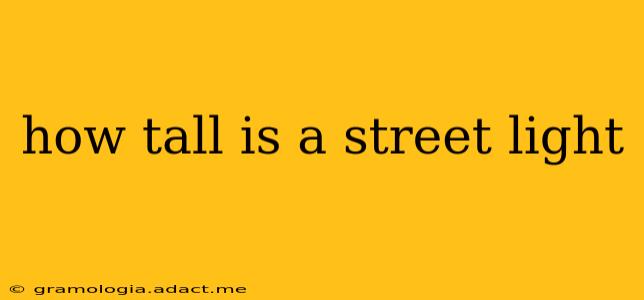How Tall Is a Street Light? Shining a Light on Height Variations
The height of a street light isn't a one-size-fits-all answer. It varies considerably depending on several factors, making a definitive answer impossible without more context. Let's explore the key influences and common height ranges.
What Factors Determine Street Light Height?
Several factors influence the height of a street light:
-
Location: Street lights in residential areas tend to be shorter than those on busy highways or major roads. Residential areas might prioritize aesthetics and less disruptive light pollution, opting for shorter poles. Highways, needing to illuminate larger areas and offer better visibility for drivers, often use taller poles.
-
Type of Light Fixture: Different light fixtures have different optimal mounting heights. High-pressure sodium lamps, for example, might be mounted higher than LEDs, due to their light dispersion characteristics. Modern LED technology often allows for lower mounting heights while still providing sufficient illumination.
-
Surrounding Environment: Obstacles like trees or buildings can necessitate adjustments to street light height to ensure adequate illumination without obstruction. Areas with dense foliage might require shorter poles to avoid being obscured.
-
Local Regulations and Codes: Building codes and local ordinances often dictate minimum and maximum heights for street lights within a specific jurisdiction. These regulations aim to ensure safety and consistency.
How High Are Street Lights Typically?
While there's no single standard height, you'll generally find street lights within the following ranges:
-
Residential Areas: Typically between 10 and 15 feet (3 and 4.5 meters). Sometimes even shorter, depending on the specific design and local regulations.
-
Commercial Areas: Often between 15 and 25 feet (4.5 and 7.5 meters), although taller ones are not uncommon, especially in areas with wider roads.
-
Highways and Major Roads: These often utilize the tallest street lights, frequently ranging from 25 to 40 feet (7.5 to 12 meters) or even higher, to maximize visibility and illumination across a broader area.
Are there different types of street lights?
Yes, absolutely! The type of streetlight also influences its height and design. You'll commonly see:
-
High-Pressure Sodium (HPS) Lights: These were once very common but are being phased out in many areas due to the advent of more energy-efficient and environmentally friendly alternatives.
-
Metal Halide (MH) Lights: These offer brighter and whiter light than HPS lamps but are also less energy efficient than LEDs.
-
Light Emitting Diodes (LEDs): LEDs are becoming the dominant technology in street lighting due to their energy efficiency, longevity, and improved light quality. They often permit lower mounting heights than older technologies.
What about the height of street light poles?
The height of the pole itself will usually be slightly taller than the height of the luminaire (the light fixture) to allow for proper mounting and clearance.
Conclusion: A Variable Height
The height of a street light is highly variable and context-dependent. While the ranges provided offer a general idea, the actual height in any particular location will be influenced by numerous factors, including the surrounding environment, the type of light fixture used, and local regulations.
